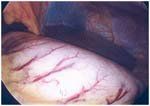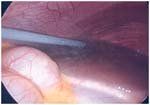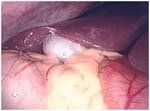Laparoscopy – A simple tip to avoid most of the post-laparoscopy pain
Laparoscopy is a minimally invasive surgical technique in which abdominal surgery is performed through tiny "keyhole" incisions on the abdomen.
FIGURE 1

View of the stomach and liver at the end of the procedure. The distension can be easily appreciated.
Laparoscopy is a minimally invasive surgical technique in which abdominal surgery is performed through tiny "keyhole" incisions on the abdomen. Images displayed on TV monitors provide magnification of the surgical field and help with accuracy and precision.
The abdomen is insufflated like a balloon, with carbon dioxide gas to elevate the abdominal wall above the internal organs to create a working and viewing space. CO2 is used because it is naturally present in the human body, can be absorbed by tissues and easily removed by the respiratory system. It is also non-flammable, which is important because electrosurgical devices are commonly used in laparoscopic procedures.
FIGURE 2

The suction irrigator is placed, all fluid and gas is started to be removed.
Advantages of laparoscopic surgery include reduced pain due to smaller incisions, decreased need for pain medications and reduced blood loss and need for transfusions due to improved visualization, and shorter recovery time. Another advantage due to the decrease in the exposure of internal organs to external contaminants is lesser risk of infection and adhesion formation.
FIGURE 3

The frothy fluid is carbonic acid formed by CO
2
and water. The rib cage is decompressing.
Unique Laparoscopic Pain
One type of pain that is unique to laparoscopy is the post laparoscopy shoulder pain due to the phrenic nerve irritation to the diaphragm caused by the CO2 gas that remains in the abdomen at the end of the procedure. When the patient sits up, the gas moves upwards to the diaphragm and irritates the shoulder. A simple technique, coined the “Air Gas Active Removal with Above the Liver Aspiration (AGARwALA) Maneuver” performed before closing the ports can significantly reduce this type of post-laparoscopy pain.
We conducted a study where we evaluated post-laparoscopy patients for pain scores and narcotic use at 1 hour, 4 hours, 8 hours or at discharge and then 24 hours and 48 hours.
FIGURE 4

The anterior wall is hugging the liver now showing removal of the CO
2
from the right upper quadrant.
Group A, 100 patients, who had a laparoscopic procedure in a standard manner ( typically an attempt is made to expel all CO2 by compressing the abdomen at the end of the procedure) and Group B, 100 patients, who had a laparoscopic procedure where all the CO2, which creates the pneumoperitoneum, was suctioned actively by placing the irrigation suction on top of the liver and removing all CO2 until the abdomen was completely desufflated. The suction irrigator was removed while water was pushed in so that there was no danger of suctioning any bowel or mesentery into the trocars. All incisions were injected with local anesthetic for uniformity.
AGARwALA Seems to Reduce Pain
The pain scores, PONV and narcotic need were all statistically significantly lower at 8, 24 and 48 hours post laparoscopy in Group B. They were also lower at 1 and 4 hours, but were not statistically significant (manuscript in preparation).
This technique can be followed during robotic surgery as well. After the robotic arms are removed from patient side, I always go back to the 5 mm laparoscope, since I start with the same. I survey the abdomen once more, make sure there is no bleeding, irrigate if needed and then remove all the gas/air from top of the liver under visualization. Remember to close off the gas supply. Then remove the suction irrigator as its delivering fluid into the abdomen. Finally the ports can be closed after all trocars have been removed. Since I am a stickler about doing this, the residents have coined it The AGARwALA maneuver.
This is how the author remembers 9/11/2001 - Performing a laparoscopic surgery with Dr. C.Y. Liu as a fellow 10 years ago. Hope everyone has a mentor like mine for life.
This work is dedicated to Dr. C.Y. Liu- Mentor, Guide and Friend to his fellows and Pioneer in the field of Laparoscopy.
References
1. C. Y. Liu, MD: My teacher and Guru, who taught me Laparoscopy and many techniques. I learned this technique first during fellowship.
2. Pain after laparoscopy, JI Alexander, British Journal of Anesthesia 1997;79:369-378
3. Obstet Gynecol. 2008 May;111(5):1155-60. A simple clinical maneuver to reduce laparoscopy-induced shoulder pain: a randomized controlled trial. Phelps P, Cakmakkaya OS, Apfel CC, Radke OC.
4. Geburtshilfe Frauenheilkd. 1980 Jul;40(7):635-43. The post-laparoscopic pain syndrome (author's syndrome). Riedel HH, Semm K.
5. Surg Endosc. 1999 May;13(5):445-8. Pain after laparoscopy. Mouton WG, Bessell JR, Otten KT, Maddern GJ.
6. Br J Surg. 2000 Mar;87(3):273-84. Pain after laparoscopic cholecystectomy. Wills VL, Hunt DR.
7. Surg Endosc. 2004 Sep;18(9):1368-73. Epub 2004 Jun 23. Low-pressure pneumoperitoneum combined with intraperitoneal saline washout for reduction of pain after laparoscopic cholecystectomy: a prospective randomized study. Barczy?ski M, Herman RM.
8. Anaesthesia. 1996 May;51(5):485-7. Does post-laparoscopy pain relate to residual carbon dioxide? Jackson SA, Laurence AS, Hill JC.
9. J Am Assoc Gynecol Laparosc. 2001 May;8(2):247-51. Effect of heating and humidifying gas on patients undergoing awake laparoscopy. Demco L.
10. Cochrane Database Syst Rev. 2011 Jan 19;(1):CD007821. Heated CO(2) with or without humidification for minimally invasive abdominal surgery. Birch DW, Manouchehri N, Shi X, Hadi G, Karmali S.
